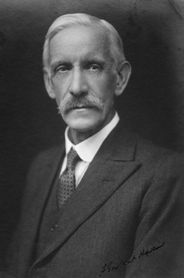Sir Frederick Gowland Hopkins, OM, FRS
1861-1947.  Reader in Chemical Physiology and Biochemistry. Awarded the Nobel Prize for the discovery of vitamins. He also discovered the amino acid. President of the Royal Society.
Reader in Chemical Physiology and Biochemistry. Awarded the Nobel Prize for the discovery of vitamins. He also discovered the amino acid. President of the Royal Society.
Sir Frederick Gowland Hopkins OM FRS was born in Eastbourne and educated at the City of London School, completing his further study with the University of London External Programme and the medical school at Guy's Hospital, now part of King's College London. He then taught physiology and toxicology at Guy's from 1894 to 1898.
In 1898 he married Jessie Anne Stevens; they had two daughters, one of whom, Jacquetta Hawkes, was married to J.B. Priestley.
Also in 1898, while attending a meeting of the Physiological Society, he was invited by Sir Michael Foster to join the Physiological Laboratory in Cambridge to investigate the chemical aspects of physiology. Biochemistry was not, at that time, recognized as a separate branch of science. In 1902 he was given a readership in biochemistry, and in 1910 he became a Fellow of Trinity, and an Honorary Fellow of Emmanuel College (where a portrait of Hopkins hangs in the Upper Hall). In 1914 he was elected to the Chair of Biochemistry at Cambridge University, thus becoming the first Professor in that discipline at Cambridge. His Cambridge students included neurochemistry pioneer Judah Hirsch Quastel.
Hopkins had for a long time studied how cells obtain energy via a complex metabolic process of oxidation and reduction reactions. His study in 1907 with Sir Walter Morley Fletcher of the connection between lactic acid and muscle contraction was one of the central achievements of his work on the biochemistry of the cell. He and Fletcher showed that oxygen depletion causes an accumulation of lactic acid in the muscle. Their work paved the way for the later discovery by Archibald Hill and Otto Fritz Meyerhof that a carbohydrate metabolic cycle supplies the energy used for muscle contraction.
In 1912 Hopkins published the work for which he is best known, demonstrating in a series of animal feeding experiments that diets consisting of pure proteins, carbohydrates, fats, minerals, and water fail to support animal growth. This led him to suggest the existence in normal diets of tiny quantities of as yet unidentified substances that are essential for animal growth and survival. These hypothetical substances he called “accessory food factors”, later renamed vitamins. It was this work that led his being awarded (together with Christiaan Eijkman) the 1929 Nobel Prize in Physiology or Medicine.
During World War I Hopkins continued his work on the nutritional value of vitamins. His efforts were especially valuable in a time of food shortages and rationing. He agreed to study the nutritional value of margarine and found that it was, as suspected, inferior to butter because it lacked the vitamins A and D. As a result of his work, vitamin-enriched margarine was introduced in 1926.
Hopkins is credited with the discovery and characterization in 1921 of glutathione extracted from various animal tissues. At the time he proposed that the compound was a dipeptide of glutamic acid and cysteine. The structure was controversial for many years but in 1929 he concluded that it was a tripeptide of glutamic acid, cysteine and glycine. This conclusion agreed with that from the independent work of Edward Calvin Kendall.
In addition to the Nobel Prize, Hopkins was awarded the Royal Medal and the Copley Medalof the Royal Society of the Royal Society. Other significant honours were his election to fellowship in the Royal Society; his knighthood by King George V; and the award of the Order of Merit. He served as President of the Royal Society from 1930 to 1935, and in 1933 served as President of the British Association for the Advancement of Science.
He is buried at the Parish of the Ascension burial ground in Cambridge.
| Memorial inscription | Translation |
|
HOC TITVLO COMMEMORATVR FREDERICVS GOWLAND HOPKINS O.M. EQ. AVR. QVI ALIMENTORVM SALVBRITATEM INDAGANDO |
This inscription commemorates Sir Frederick Gowland Hopkins, O.M. By investigating the health-giving properties of foodstuffs, he made Man’s life more stable by his discovery of vitamins. Having been at Emmanuel College, in 1910 he was appointed as Fellow and Praelector in Biochemistry at Trinity, and remained here when he was made the first Professor of Biochemistry. A man of remarkable energy and no less remarkable modesty, who had high regard for the College, he died after a long life in 1947. |
Frederick Gowland HopkinsBrass located on the south wall of the Ante-Chapel. |
Click on the thumbnail for a larger image. |
|
|
PREVIOUS BRASS |
|
NEXT BRASS Fenton John Anthony Hort |
| Brasses A-B | Brasses C-G | Brasses H-K | Brasses L-P | Brasses R-S | Brasses T-W |

